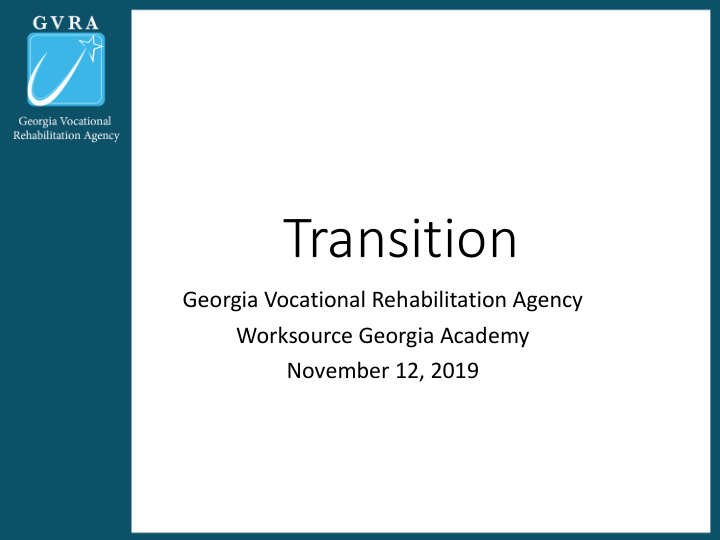



Transition Georgia Vocational Rehabilitation Agency Worksource Georgia Academy November 12, 2019
Wha What t ar are “Trans ansitio ition” n” Servic vices? • Transition services provide those critical services that help “bridge the gap” for students and their families as they plan for leaving high school and their post- secondary plans. • State vocational rehabilitation programs have long provided these services. What is different now?
WIOA places heightened emphasis on the provision of services necessary to assist youth with disabilities, including youth with the most significant disabilities, to achieve competitive integrated employment in the community, including supported or customized employment.
Th Three Cr Critical WI WIOA Ex Expe pectatio tions ns of Vo Vocational Rehabilitation Agencies 1) Strengthening the alignment of the VR program with the other core programs within the workforce development system. 2) Emphasizing the achievement of competitive integrated employment by individuals with disabilities, including individuals with the most significant disabilities. 3) Expanding services to support the transition of students and youth with disabilities from secondary education to postsecondary education and employment through Pre-Employment Transition Services (Pre-ETS).
Pr Pre-Employm yment Transition Services (P (Pre-ET ETS) • Pre-ETS provide high school students an early start with their career exploration and planning. • Pre-ETS must be available to students with disabilities in need of such services, regardless of whether a student has applied and been determined eligible for VR Services. • Services may be provided by VR staff, collaboration with school educators or by service providers in group settings or on an individual basis. • Pre-ETS services must be provided or arranged in collaboration with the Local Education Agency (LEA).
Pr Pre-Employm yment Transition Services (P (Pre-ET ETS) • Pre-ETS may begin upon student request or upon recommendation for one or more pre- employment transition services and documentation of a disability is provided to VR. • Pre-ETS can be provided to younger in-school youth beginning at age 14 and through age 21. • Services should be sequenced to provide a hierarchy of exploration and exposure. • Those students who may require more supports and individualized services can apply for VR eligibility.
Fi Five (5) Required Pre-Employm yment Tr Transition Services • Job Exploration Counseling • Work-Based Learning Experiences • Counseling on Post-Secondary Opportunities • Workplace Readiness Training • Instruction in Self-Advocacy
Job Job E Explor oration on Cou Counsel eling Examples: • Employment information regarding high demand jobs and traditional jobs; • Labor market information; • Administration of vocational interest inventories; • Hands-on career exploration activities; • Identification of career pathways that match a student’s interests.
Wo Work-Ba Based L Learning E g Experiences Examples: • School based job training with employer interviews; • Work-Site Training; • Industry and Work Site Tours; • Job Shadowing & Volunteering; • Internships; • Apprenticeships; • On-the Job Training (OJT).
Cou Counseling on g on P Pos ost-Secondary y Op Opportunities Examples: • Providing information regarding the college application and admissions process; • Identifying resources that may used in support student success in education and training (College Disability Support, etc.); • Completing the Free Application for Federal Student Aid (FAFSA); • Advising regarding academic and training course expectations.
Workp kplace Readiness Training Examples: • Training to understand employer expectations in the workplace; • Training to develop necessary soft skills & interpersonal skills; • Training in effective communication in the workplace; • Training to develop job seeking skills; • Orientation & mobility training to support access to workplace readiness training or to learn to travel independently.
In Instru ruction in Sel elf-Ad Advoc ocacy • Instruction in understanding rights and responsibilities; • Instruction in how to request accommodation, services and supports; • Mentoring with individuals employed or volunteering with school staff or with an employer in an integrated community setting; • Participation in youth leadership activities through educational or community settings.
GV GVRA Transition & Pre-ET ETS • GVRA is committed to effective processes and procedures that support a “culture of transition” within our organization. • Transition within GVRA is not a separate unit, but rather a collaborative, structured approach within VR Field Services to best meet the needs of students, their families, teachers, our staff and partners. • GVRA wants to ensure the most effective supports and services are in place to prepare students for competitive, integrated employment, attending post-secondary education/training and entering the workforce.
VR Service ces – FY FY 19 19 • VR worked with over 20,000 students with disabilities who received Pre-ETS services. • GVRA initiated internal controls to better monitor and document Transition and Pre- ETS services. • Leadership prepared for the 5 th and final year of a federally funded Career Pathways grant to support statewide initiatives to provide best practice transition services and serve more students with disabilities.
FY FY 20 20 In Initi tiati tives es & Goals • Local LEA & VR Field Services collaboration. • Individualized Pre-ETS Needs Assessment with the development of an agreed upon Pre-ETS plan for the year ahead for each High School. • Leveraging of resources (staff, partners & funding) through local planning. • Planning to support sequential Pre-ETS services and effective Transition outcomes. • VR & GaDOE collaboration for staff training and learning opportunities.
FY FY 20 Initiatives s & Go Goals • Transition Talk – a twice a month web-based platform to share information with VR staff. • Under Development • VR Transition Website –a robust website for VR staff, students, families and partners. • VR Transition Guide –a desktop resource for VR professionals to share best practice strategies for successful transition and VR transition procedures. • Extensive Staff Training through multiple platforms for VR professional skill development.
GV GVRA Points of Contact • Ms. Kathryn Edger – Kathryn.Edger@gvs.ga.gov • Dr. Karla Wade – Karla.Wade@gvs.ga.gov • Dr. Lee Brinkley Bryan – Lee.Bryan@gvs.ga.gov • Georgia Vocational Rehabilitation Agency – https://gvs.georgia.gov/
Recommend
More recommend